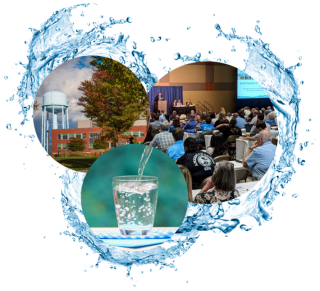20th Annual EPA Drinking Water Workshop: Session 3B

Methods and Analytics
Track B: Source, Treatment, and Operations
Presentation summaries and speaker and moderator biographies for Session 3B of the 20th Annual EPA Drinking Water Workshop.
September 12, 2023 from 1:30 to 3:15 p.m. ET
See the full workshop agenda for all sessions.
Moderator:
Melissa Simic, M.S. | EPA Office of Water
Melissa has been a physical scientist with EPA for 15 years. She works in the Office of Ground Water and Drinking Water’s Standards and Risk Management Division as the Branch Supervisor for the Unregulated Contaminant Monitoring Branch. She manages the rule development and implementation of the Unregulated Contaminant Monitoring Rule (UCMR). Melissa holds and M.S. in environmental epidemiology, exposure, and risk from Harvard University and a B.S. in cell and molecular biology from Oklahoma State University.
Update on the Fifth Unregulated Contaminant Monitoring Rule (UCMR 5)
EPA's Unregulated Contaminant Monitoring Rule (UCMR) provides national occurrence data for unregulated contaminants in public drinking water to protect public health and support future regulatory decisions. The UCMR 5 requires monitoring for 29 per- and polyfluoroalkyl substances (PFAS) and lithium by over 10,300 public water systems between January 2023 and December 2025. This presentation provides an overview of the UCMR 5 program and monitoring requirements for water systems, information on data access, resources for understanding the data, and a summary of the UCMR 5 results to date.
Kelsey Dailey, M.S. | EPA Office of Water
Kelsey is a physical scientist with EPA’s Office of Water’s Office of Groundwater and Drinking Water, Standards and Risk Management Division, Unregulated Contaminant Monitoring Branch, in Cincinnati, Ohio. She works primarily on implementation of the Fifth Unregulated Contaminant Monitoring Rule (UCMR 5), rule communications and outreach, and data management. She has participated in UCMR program activities since January 2021 when she first arrived at EPA as an Oak Ridge Institute for Science and Education (ORISE) research fellow. Kelsey holds an M.S. in environmental studies specializing in hydrologic sciences from the University of Colorado Boulder and a B.S. in geological sciences from The Ohio State University.
Legionella Methods
This presentation will give a brief history of the bacterium Legionella, the causative organism for Legionellosis. Along with the history, this presentation will describe the current methods available for quantifying and culturing this organism from water.
Laura Boczek, M.S. | EPA Office of Research and Development
Deborah is an environmental engineer with EPA’s Office of Water, Office of Ground Water and Drinking Water, where she has worked on drinking water rule development and implementation, workforce development, distribution system water quality issues, and technical assistance projects. Before joining EPA in 2016, she worked as a water quality and regulatory compliance engineer at the Alameda County Water District in Fremont, California and served as a water and sanitation volunteer in the Peace Corps in Peru. Deborah holds an M.E. in water quality and environmental engineering from Massachusetts Institute of Technology, an Sc.B. in civil and environmental engineering from Brown University, and she is a registered professional engineer in the District of Columbia.
Advances in Sensory and Analytical Techniques for Harmful Algal Blooms and Monitoring for Taste and Odor Compounds
Proactive drinking water utilities are seeking streamlined approaches to monitor and mitigate harmful algal blooms (HABs) and taste and odor compounds (T&O). There is no single method that answers all the fundamental questions needed to make determinations on the source of HABs and T&O compounds, their concentrations, and to make treatment decisions. By using an integrated approach of sensory and analytical analyses, utilities can detect blooms and T&O events early to make treatment decisions before problems become too large to easily mitigate. This presentation will review a brief history of T&O analysis, major sensory and analytical chemistry methods, and recent advances in T&O monitoring such as the addition of the Attribute Rating Test to Standard Methods and the revision of Standard Method 6040D to include 20 T&O compounds, along with recent advances in treatment optimization for T&O compounds.
Hunter Adams, M.S. | City of Wichita Falls-Cypress Environmental Laboratory
Hunter is the laboratory supervisor for the Cypress Environmental Laboratory, owned and operated by the City of Wichita Falls, Texas. He is a licensed Double A Water Operator and Wastewater Treatment Operator by the Texas Commission on Environmental Quality. Hunter received the WEF Laboratory Analyst Excellence Award in 2020, and an APEX Award for Publication Excellence for the “Operators Need to Know” Opflow series in 2023. He has given over 60 conference presentations and webinars and authored over 100 articles. Hunter serves as a member of the TNI Microbiology Expert Committee and the APHL Environmental Laboratory Sciences Committee and is on several committees with AWWA and WEF. He is the chair of the AWWA Water Quality Laboratory Committee, serves as the coordinator for the Standard Methods Acting Part 6000–Individual Organic Compounds, and is on the Opflow Editorial Advisory Board. Hunter holds an M.S. and a B.S. in biology from Midwestern State University.
Disclaimer: The views expressed in these presentations are those of the authors and do not necessarily represent the views or policies of the U.S. Environmental Protection Agency. Any mention of trade names or commercial products does not constitute EPA endorsement or recommendation for use.
